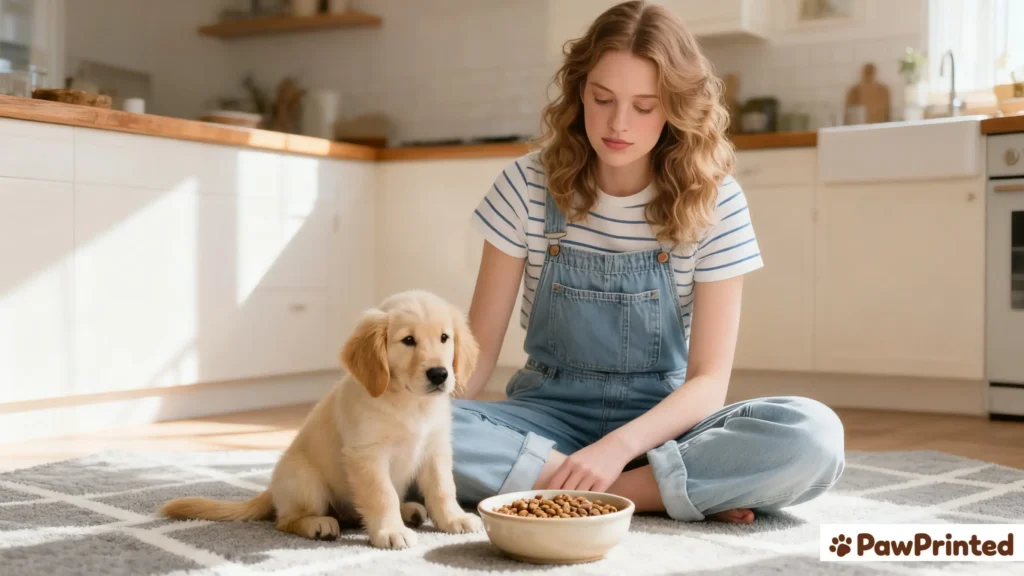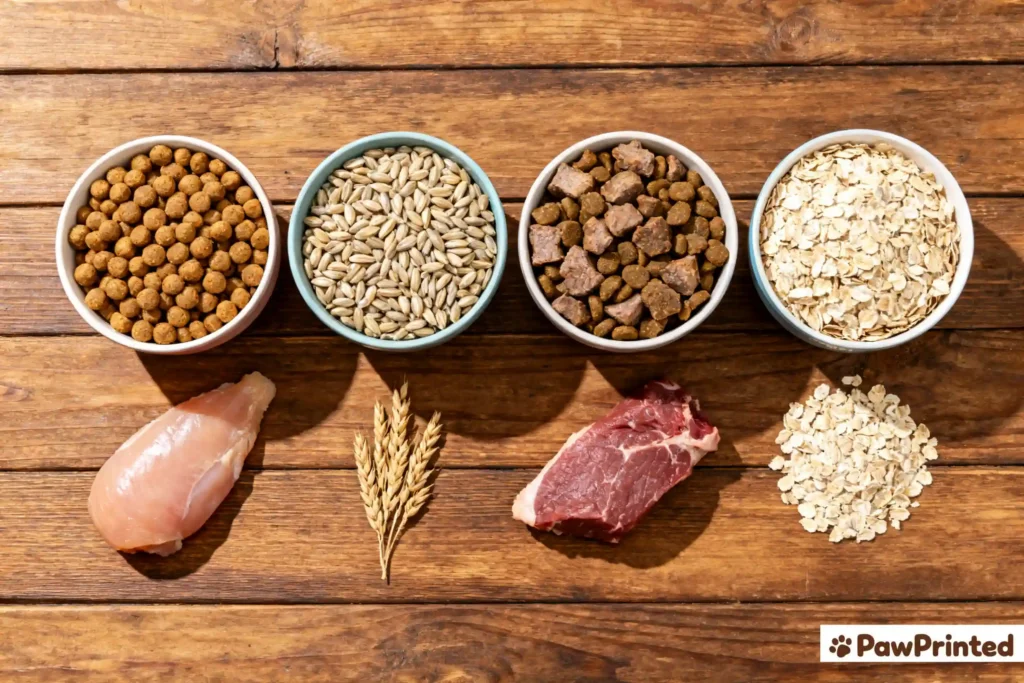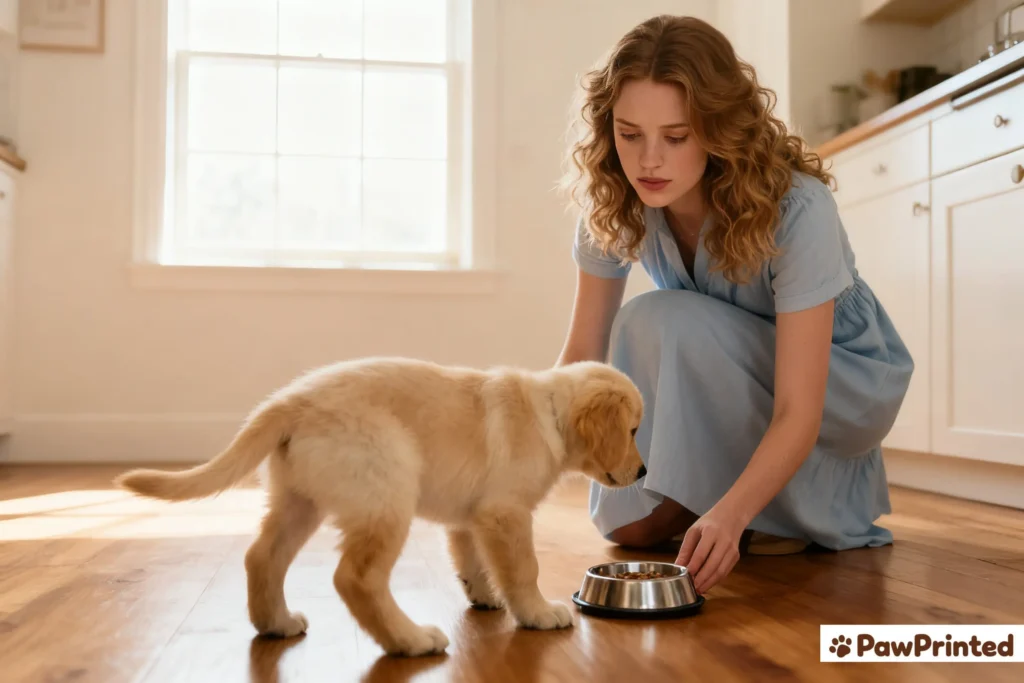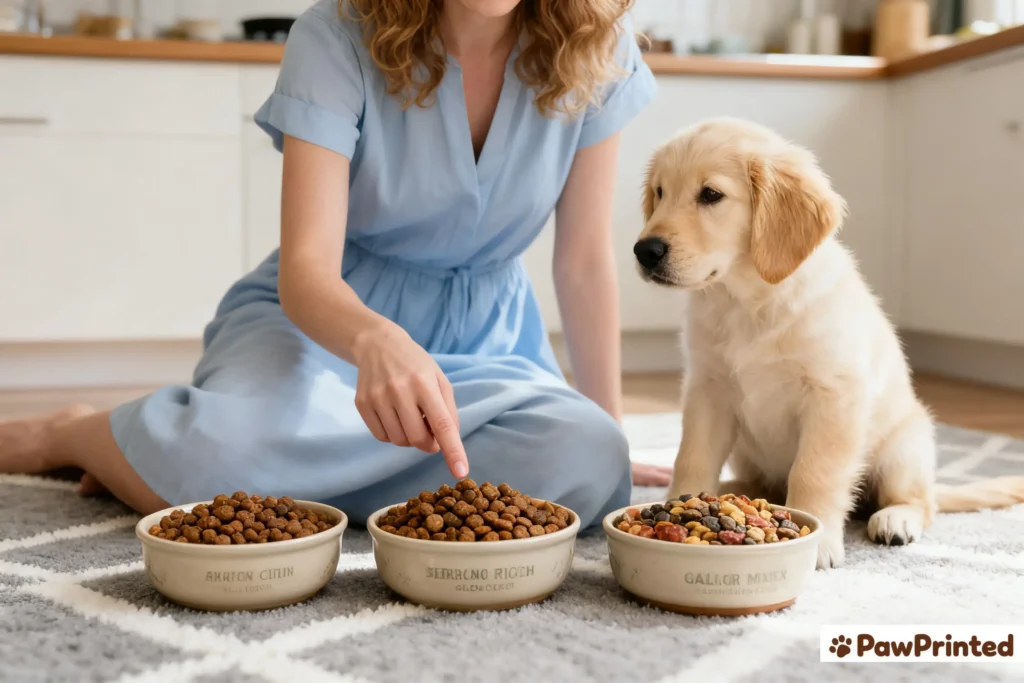Gentle formulas for digestion, steady growth, and shiny coats
When Ethan came home at 10 weeks, we faced the classic puppy puzzle: boundless energy, a tiny tummy, and way too many kibble options. Our first pick looked great on paper, but the transition was rough—soft stools, late-night cleanups, and a pup who nibbled without enthusiasm. After a few careful switches (and some vet notes), we learned to prioritize puppy-specific nutrition, easy-to-digest recipes, and a slow, consistent routine. The blends below are the ones that actually settled Ethan’s digestion while supporting growth and a glossy coat.

Before You Switch: Red Flags (See Your Vet)
⚠️ Persistent vomiting, bloody or black stools, weight loss, extreme lethargy, or dehydration are medical red flags—see your vet before making diet changes. Food can support recovery, but it should not delay treatment.
What Actually Worked for Our Puppy (Story Style)
On sleepy mornings when Ethan’s tummy felt touchy, we stuck with a gentle chicken & barley base. Small bites made chewing easier and transitions smoother—exactly why Hill’s Puppy Small Bites stayed in our pantry. On active training days, Ethan thrived on a protein-forward blend; the added DHA for brain development made Purina Pro Plan Puppy (Chicken & Rice) an easy win—his appetite stayed steady and stools well-formed.
During his “picky eater” phase, a no-corn/wheat/soy option sparked his interest again with Blue Buffalo Life Protection Puppy. For coat shine, a balanced fiber profile from Wellness Complete Health Puppy kept digestion regular. When sensitivity flared, a lamb-first recipe like Nutro Lamb & Brown Rice Puppy was gentler on his stomach. For our friends with toy breeds, tailored kibble—Royal Canin Small Puppy—made mealtime exciting with crunch-happy enthusiasm.
If your pup needs a grain-free route, see our Best Grain-Free Puppy Food guide. Families raising tiny pups often check Best Puppy Food for Small Breeds, while large-breed homes may prefer structured growth diets from Best Puppy Food for Large Breeds.

Why Puppy Food Needs Special Care
Growth targets: Puppies need higher protein and fat to build muscle, organs, and a healthy coat—look for puppy-specific formulas with DHA/ARA to support brain and eye development. For fundamentals, see the AKC’s overview on puppy nutrition.
Calcium–phosphorus balance: Appropriate Ca:P helps bones and joints, especially in medium/large breeds. Too much or too little can be risky, so stick to a complete puppy diet rather than stacking multiple fortified feeds. See VCA’s practical primer on feeding growing puppies.
Digestive learning curve: New foods, teething, and stress can wobble stools. Transition slowly and anchor a consistent feeding schedule. If your pup tends toward tummy upsets, keep these references handy:
- Best Dog Food for Sensitive Stomach & Diarrhea
- Dog Supplements for Sensitive Stomach
- Dog Food Transition Guide
- Dog Food for Allergies (Hub)

Our Simple Routine (3 Steps)
- Feed small, frequent meals: 3–4 times/day at predictable hours to avoid sugar dips and stomach overload.
- Hydrate the kibble: Add warm water to soften pieces for teething puppies and ease digestion.
- Support the gut: Use a vet-approved probiotic during transitions (see our supplement picks).
Comparison Table (Quick Picks)
| Option | Why It Helps | Best For |
|---|---|---|
| Hill’s Puppy Small Bites (Chicken & Barley) | Vet-recommended; small kibble for easy chewing; steady stools | General growth; small mouths; gentle transitions |
| Purina Pro Plan Puppy (Chicken & Rice) | Higher protein; DHA for brain/vision; strong palatability | Active puppies; training days |
| Blue Buffalo Life Protection Puppy | No corn/wheat/soy; antioxidant blend | Picky eaters; light sensitivities |
| Wellness Complete Health Puppy | Balanced fiber; coat & skin support | Coat shine; regular digestion |
| Nutro Puppy (Lamb & Brown Rice) | Lamb-first; gentle on tummies | Sensitive stomach; transition-prone pups |
| Royal Canin Small Puppy | Breed-tailored kibble size & nutrients | Small breeds; enthusiastic chewers |

FAQ
Can puppies eat adult dog food?
Not as a routine. Puppies have different macro- and micronutrient targets (including DHA and minerals). If you ran out briefly, transition back to a complete puppy formula as soon as possible and use a slow 7–10 day blend.
How many times a day should puppies eat?
Most do well with 3–4 small meals/day. Smaller, consistent portions help stabilize digestion and energy. Keep treats <10% of daily calories and let stools guide pace/volume.
When should I switch from puppy to adult food?
Small breeds often switch around 10–12 months; large/giant breeds closer to 12–18 months. Use growth rate, energy level, and body condition—not just the calendar. Transition over 7–10 days.
Can probiotics help a puppy’s digestion?
They can—especially during food transitions or mild stress. Choose a puppy-safe, vet-approved product and give it 1–2 weeks. If diarrhea persists or red flags appear (blood, lethargy, weight loss), see your veterinarian.
What’s the best food for a picky-eater puppy?
First rule out upset from too-fast changes or too many treats. Try warm water on kibble, smaller meals, and a formula with strong palatability or a different protein (e.g., lamb instead of chicken). Pair choices with your puppy’s size and sensitivity profile; use our allergy hub if you suspect specific ingredients.
Heads up: If you don’t want to cook daily, check our dry food picks — those were Ethan’s daily backups.
Wrapping It Up
Every puppy is a little different—our job is to make changes gently, watch stools and energy, and follow the plan that keeps growth steady and tummies calm. If you’re stuck, start with a gentle chicken-and-barley base, keep portions consistent, and add DHA-rich options as training ramps up. Comment with your pup’s age, breed, and what you’ve tried—we’ll point you to a fit.
Follow PawPrinted On Pinterest
Want puppy-feeding routines, gentle transitions, and training-day meal ideas? Follow us on Pinterest and save your favorite setups — we share fresh inspo every week!

